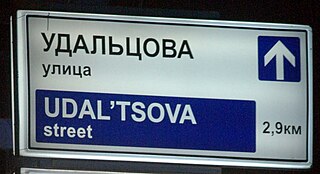| 8th Cavalry Division | |
|---|---|
| 8-я кавалерийская дивизия | |
| Active | 1875–1918 |
| Country | |
| Branch | |
| Role | Cavalry |
| Engagements | |
The 8th Cavalry Division (Russian : 8-я кавалерийская дивизия, translit. 8-ya Kavaleriiskaya Diviziya) was an cavalry formation of the Russian Imperial Army, part of the 8th Army Corps. It was headquartered at Kishinev by 1914. [1]

Russian is an East Slavic language, which is official in the Russian Federation, Belarus, Kazakhstan and Kyrgyzstan, as well as being widely used throughout Eastern Europe, the Baltic states, the Caucasus and Central Asia. It was the de facto language of the Soviet Union until its dissolution on 25 December 1991. Although, nowadays, nearly three decades after the breakup of the Soviet Union, Russian is used in official capacity or in public life in all the post-Soviet nation-states, as well as in Israel and Mongolia, the rise of state-specific varieties of this language tends to be strongly denied in Russia, in line with the Russian World ideology.

Romanization of Russian is the process of transliterating the Russian language from the Cyrillic script into the Latin script.

Cavalry or horsemen are soldiers or warriors who fight mounted on horseback. Cavalry were historically the most mobile of the combat arms. An individual soldier in the cavalry is known by a number of designations such as cavalryman, horseman, dragoon, or trooper. The designation of cavalry was not usually given to any military forces that used other animals, such as camels, mules or elephants. Infantry who moved on horseback, but dismounted to fight on foot, were known in the 17th and early 18th centuries as dragoons, a class of mounted infantry which later evolved into cavalry proper while retaining their historic title.

